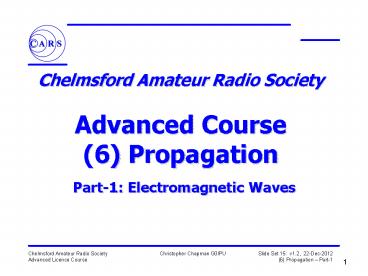Chelmsford Amateur Radio Society Advanced Course (6) Propagation Part-1: Electromagnetic Waves - PowerPoint PPT Presentation
Title:
Chelmsford Amateur Radio Society Advanced Course (6) Propagation Part-1: Electromagnetic Waves
Description:
Title: Propagation Part-1 - EM Waves Subject: Advanced Course Author: Christopher Chapman G0IPU Description: EM Graphic By M Niman G6JYB Others by Andrew Chapman G7TKK – PowerPoint PPT presentation
Number of Views:141
Avg rating:3.0/5.0
Title: Chelmsford Amateur Radio Society Advanced Course (6) Propagation Part-1: Electromagnetic Waves
1
Chelmsford Amateur Radio Society Advanced
Course(6) Propagation Part-1 Electromagnetic
Waves
2
Electromagnetic Waves
- Electromagnetic radiation comprises both an
Electric and a Magnetic Field - The two fields are at right-angles to each other,
and the direction of propagation is at
right-angles to both fields - The Plane of the Electric Field defines the
Polarisation of the wave - The relationship between the magnitudes of the E
and H fields is constant
3
EM Wave Fronts head-on
Electric Field (E)
Magnetic Field (H)
4
EM Wave Fronts head-on
Electric Field (E)
Magnetic Field (H)
5
Electromagnetic Radiation
- In free space conditions Electro-Magnetic (EM)
waves travelin straight lines and spread out - Both Power Flux Density (PFD) in W/m2 and Field
Strength in V/m, drop with distance - Double the distance from an antenna and you
willhalve the field strength, but also quarter
the Power Flux Density (PFD), according to an
inverse square law
6
EM Field vs Distance
Rx
Tx
7
Inverse Square Law forDistance and Intensity
- Relationship between distance and intensity of
electromagnetic radiation (rf or light) - Inverse square gives a 1/d2 reduction
- Example
- D 1m - Intensity 1
- D 2m - Intensity ¼
- Doubling the distance spreads same amount of
energy over four times the area
8
Another PFD Example
9
Velocity Of Propagation
- Propagation velocity depends on the medium in
which EM waves travel - Free Space ? Maximum velocity
- Air ? slightly less than free space and dependent
on water vapour - Coax ? 0.66 Times that of Free Space
- Water ? far less, and lossy
- v f . ?
- v is the speed of radio waves light - v
300,000,000 m/s - f is the frequency in Hz.
- ? is the wavelength in metres
- For l /4 for 2m
- 300 /145.5 x 0.66 / 4 Coax length 340.2mm
10
Linear Polarisation
- Transmit and receive antennas should have the
same polarisation - To be efficient...
- Otherwise, signal strength may be reduced by up
to 32dB - Polarisation losses can be up to 5 S-points
- Note that after travelling through the
ionosphere, the polarisation may have changed
significantly
11
Circular Polarisation
- The E-field of the wave rotates as it propagates,
with either - Left-handed polarisation (LHCP) (anticlockwise
from behind) as shown, or - Right-Handed polarisation (RHCP) (clockwise from
behind)
Electric Field, E
Magnetic Field, H
Direction of Propagation
- Used for satellite comms where the orientation
of the EM field from the satellite is
indeterminate - Make sure you receive correct circular
orientation or high polarisation losses will
result
12
Helical Antennas for Circular Polarisation
- 2.4 GHz Helical Antenna
- Designed for OSCAR 40
- Omni-directional Quadrifilar Helical RHCP
antenna































